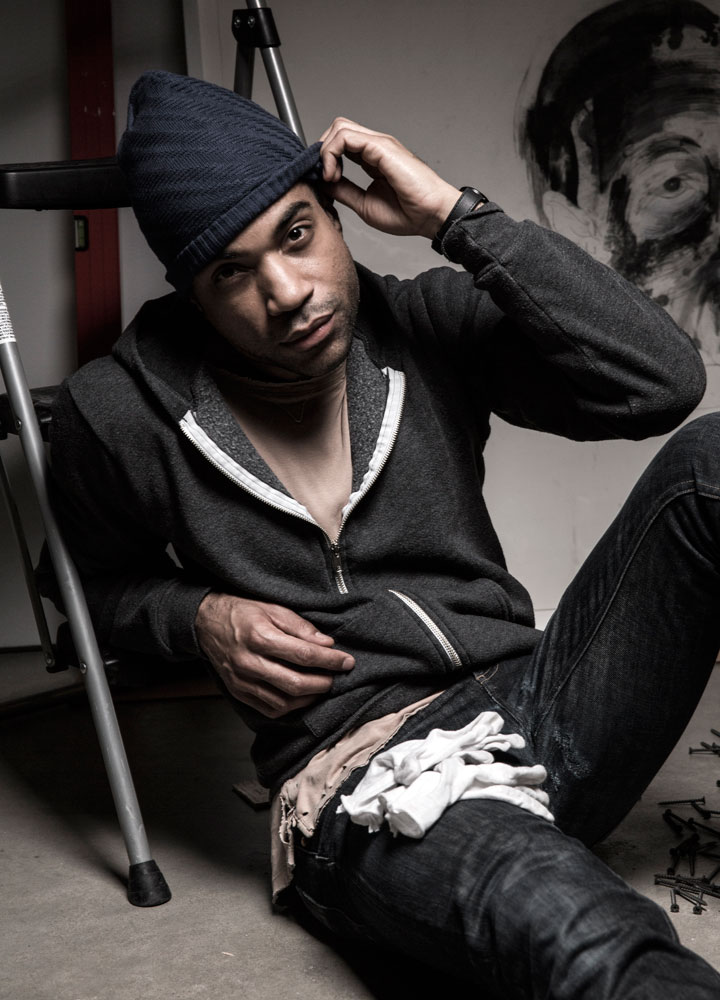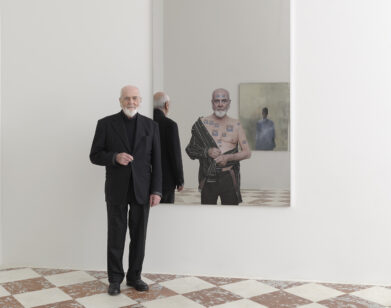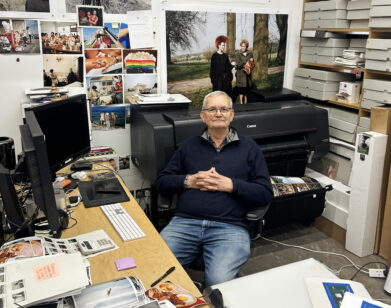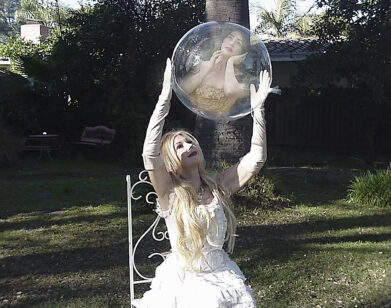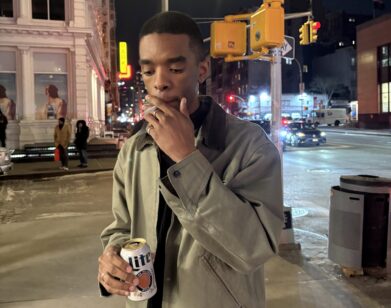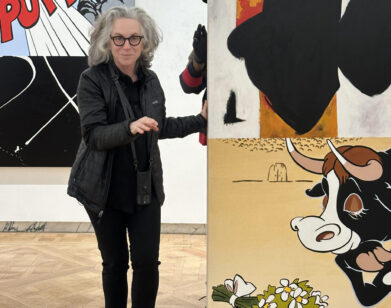Hermaphroditic Beauty
ABOVE: WARDELL MILAN IN NEW YORK, FEBRUARY 2015. PORTRAIT BY FRANK SUN.
Although they made artworks during three disparate eras, George Grosz, Andy Warhol, and Wardell Milan share the ability to create striking line drawings with a focus on the human body. Recognizing the similarities, David Nolan and Maureen Bray, owner and director of David Nolan Gallery respectively, curated the tri-generational group show “The Confident Line,” which is now on view.
In the gallery’s main room, contours drawn in the 1920s by the Neue Sachlichkeit and Dada artist Grosz hang interspersed with Warhol’s pop-slanted caricatures and Milan’s eerie hermaphrodites. In a smaller, second gallery Milan showcases assemblage appropriations of images from Paolo Roversi’s book Nudi alongside more Grosz and Warhol sketches. None of the images are labeled on the gallery walls. Rather, viewers must identify artistic stylistic nuances with their own eye or use an imagery checklist, forcing the focus onto the works of art instead of the prominent names.
Many of the works on view appear as straightforward portraits or quick renderings from afar, but closer inspection reveals deeper layers, particularly in Milan’s series of hermaphrodites. “I like this idea of creating duality of this uncomfortable shift for the viewer when they’re looking at the work,” Wardell says.
The Knoxville-born, New York-based artist’s use of white pastel and acrylic atop black graphite allows for the blending of colors, literally creating shades of grey that mimic the duality of his subjects’ genders, as figures have both women’s breasts and male phalluses. This mixing of media and genitalia reflects Milan’s oeuvre, which often blends drawing, painting, photography, and the construction of dioramas to comment on the themes of beauty and sexuality in contemporary society.
We spoke with Milan, who attended the University of Tennessee and the Skowhegan School of Painting and Sculpture in Maine before receiving his MFA from Yale, prior to the opening of the exhibition.
EMILY MCDERMOTT: I know you’ve been creating art for a really long time, but going back to childhood, when did you first become interested in art?
WARDELL MILAN: Since my earliest memories. One of my earliest memories is my mother taking me to an art classes on a Saturday. My parents recognized early on my interest in art. They wanted to nurture and foster that, so they put me in art classes. I remember staying after school in third grade and there was this after school art class in the library. So, super young—it’s been a long time of taking courses, whether they’re in academia or little private classes that my parents enrolled me in.
MCDERMOTT: What was one of the first artists you saw or pieces that really stood out to you?
MILAN: It was actually Madonna’s video “Vogue.” [laughs]
MCDERMOTT: Really? That’s great. What about it caught your attention?
MILAN: I didn’t know what I was looking at. I mean, I knew what I was looking at, I knew I was attracted to the black-and-white images. I can describe it now—I was attracted to the sexuality that was in the video. But when I was a kid, it was really the lighting and the theatrics and these little vignettes that were created, just being intrigued by that and it holding my attention. Like, “What is this? I want to see and know more about this visual thing that peaks my curiosity.”
MCDERMOTT: Have you ever dabbled in video art?
MILAN: Yeah, in undergrad I did a lot of video, but I haven’t dabbled seriously.
MCDERMOTT: With your figures, do you look at specific people when you are making them?
MILAN: I look a lot through magazines and books, but I don’t have live models or do any life drawings. The hermaphrodites that are in the drawings come from E.J. Bellocq, he photographed these prostitutes in New Orleans. The name of the book is Storyville. I’ve been a fan of his work for a long time and really enjoyed the photographs that he made. They are very loving, some of the photographs, and then other times they are a little macabre because he scratches out the heads or faces or a female’s arm. But I just like the way that he treated the subjects in the images. So that was kind of the source material, the jumping off point, for these drawings—appropriating those models and using them for my own.
MCDERMOTT: When you see a photograph or an image, how do you know that’s what you want to use? What’s the creative process like for you?
MILAN: Sometimes I have no idea. The collages from Paolo Roversi’s book Nudi, I had his book for years and I knew I wanted to do something with the images, but I didn’t know exactly what or how that was going to mature and develop. I’m not sure when the moment was or how it happened, but there’s this “aha!” moment. I slowly began to make this body of work and generate these types of images and do it in a way where I was confident and I knew what I wanted from the pages, what I wanted from these women. I like the idea of collaborating with artists and photographers who I may never meet or have the opportunity to collaborate with.
MCDERMOTT: Would you want to do a collaboration where you know the artist or do you prefer just taking what exists and appropriating it?
MILAN: That’s really interesting….I didn’t think about [it]. Since I already have done these collaborations where I’m taking these images and appropriating them, it would be fun to work with them directly. I really enjoyed the work of Steven Klein. [laughs] I mean he’s out there, so I wouldn’t mind working with him. I think my dream collaboration perhaps Steven Klein and Joel-Peter Witkin.
MCDERMOTT: I saw that he was one of your influences. You used his stuff for some of your other collages right?
MILAN: Yeah. I appropriated a lot of his images for my dioramas. None of those photographs will be in this show, but I think those two are a little crazy; they really understand the worlds that they create. I would love to be sandwiched in them, like, “What can we do?” I think we could come up with something sinister and crazy.
MCDERMOTT: Most definitely. So sexuality obviously plays a huge role in all of your work. How did that start?
MILAN: It probably started in undergrad, though I didn’t really know it then. In undergrad, it was my freshman or sophomore year, I was understanding my own sexuality and slowly coming out to my family and parents and friends. So, making photographs that dealt with the understanding of who I am as a gay man and dealt with the process of accepting that, and also accepting what I’m into sexually, what sexually arouses me. So I was making these images not necessarily knowing what they were about, but just putting it out there—that mode of thinking or consideration of my own desires, and also the much larger conversation around images that deal with ideas of sexuality and how those images are distributed and then accepted or understood by whoever is viewing those images.
But in this work, in the collages, I’m interested in the idea of not only appropriating the photographs of these women, but also the idea of femininity and the idea of sexuality. The images were taken by a man and I am again appropriating these images and working with the female form to re-contextualize the figure or to place them in strange landscapes. I’m aware that I’m using ideas of femininity and sexuality, but when I look at them, I think about them using sexuality as a way of exerting power, as a way of affirming themselves. I don’t see it as something that is looked upon as a negative or seen as a rejection. These women are embracing their sexuality and have a sense of power of using their sexuality.
MCDERMOTT: Which is interesting because these [collages] show confident femininity and the others blur sexual identities.
MILAN: Yeah, with the hermaphrodite drawings there is definitely this blurring of sexuality. Part of it is this really obvious—you know, man, woman—and the other is this conversation about sexuality…sexuality isn’t these two binaries; it’s really gray. That’s where the conversation for those drawings began and that thinking is further explored in photographs that I’m currently making. These drawings are kind of setting up for other work, but with the hermaphrodite drawings, it’s definitely the idea of sexuality being really gray and also thinking about transformation in the body. A few years ago, I made these drawings of female body builders. I was interested in this idea of body modification, transforming the body, and pushing the female body to limits where it becomes unrecognizable.
MCDERMOTT: Why the female body?
MILAN: When looking at female body builders and reading about the industry and the culture, their bodies just break down. They end up having to get breast implants and not having menstrual cycles. The obsession of pushing your physical self way beyond what nature is expecting is really interesting. I liked the idea of these women; it’s their career, but it’s also their obsession.
MCDERMOTT: So what are the photographs you’re working on now? Can you allude to that, or not yet?
MILAN: [laughs] I’ll be vague. They deal with things that are seen in the works here in the show—the themes of femininity, body modification, love and melancholy, and sexual perversions.
MCDERMOTT: You’ve worked with so many different mediums. What’s the process of choosing what you’re going to work with?
MILAN: I don’t really go in stages. In the studio I’m working on everything at once. So there’s a drawing happening, then there’s a diorama being built, and then there’s a painting that’s also being worked on. I was going to say [it depends on] the subject matter, but that’s not necessarily true because the threads all intertwine. So I guess it depends on how I want to interpret the idea. Sometimes the interpretation works best in a photograph, and then sometimes it works best in a drawing. But most often times, with the work, everything starts with the diorama with the photograph. Then I’m just filtering out ideas and images from the photograph and reinterpreting them in other mediums.
MCDERMOTT: I also wanted to touch on the theme of beauty because that’s another topic a lot of your images deal with. How do you see beauty in the images? What is that role in comparison to the sexuality?
MILAN: Beauty has always been a strong component in the work. I like the idea of appropriating a beautiful image—you can use those collages as an example—then deconstructing the collage and the idea of the supermodel, and then piecing the image back together. Sometimes when you’re piecing it back together, the figure may appear slightly grotesque but there’s still a level of beauty and attraction. I like creating these moments where there’s this dichotomy between something that repels you but is still so attractive that you can’t stop looking. You still want to acquire it; there’s still that level of aspiration for the image of the figure or the person you’re looking at. when you look at the work there’s this, “Oh it’s really beautifully rendered!” or, “I love those beautiful tones.” There’s some aspect that’s really attractive but the image itself could be slightly distributing.
MCDERMOTT: Do you think that growing up in Knoxville, or the South in general, has influenced your opinion and views?
MILAN: I think that growing up in Knoxville has strengthened my imagination because there ain’t shit to do in Knoxville. [laughs] Especially when I was growing up, there was very little to do, and my parents really pushed me to go outside and my father built tree houses. They were always like, “Build something and be active!” I think growing up there generated my curiosity and imagination, but some of the other things just developed over time as I grew into an adult.
Some of the ideas, especially beauty, really were developed when I worked at Box Studios. I worked there and that’s actually when I first saw Paolo Roversi’s images, because I was working on his work. To see these images of celebrities and supermodels—yes, these people are really beautiful, but then to see the process of how not only the photograph, but also their physical selves, were tweaked to make them even more beautiful or give them a better body, and how it was approved by the photographer, the photo editor, and then printed in a magazine. Then women in our office get the magazine and they’re like, “Oh my god she’s so pretty! She has an amazing body!” And I’m like, “We retouched these images! They’re fantastic, but we know that she has a missing toe!” [laughs] So the idea of how beauty is represented and how people accept or digest it…working there increased my understanding of how these pages and images are understood, or not understood.
MCDERMOTT: Now that you are doing photography yourself, would you ever consider doing manipulations on the computer instead of physical alterations and appropriation?
MILAN: Well with the dioramas, the film is digitally scanned and then there’s a digital C-print. So there’s manipulation in terms of color or taking out dirt spots. If I am photographing live people I guess it would depend on the project. If I’m making work that comments on that culture, then absolutely, I’ll just push it. I would go all the way to really make conversation.
MCDERMOTT: How would you describe your philosophy or approach toward art?
MILAN: Every time I’m in the studio, I always think of my professor in undergrad. He was like, “There are so many artists in the world. If you’re going to be an artist, make sure you have something to say. Don’t just be an artist and put out bullshit. Have something to say.” I guess that would be my philosophy and something I think about all the time. Every day when I’m in the studio I hear him and I see him. I remember him saying it in class. So that’s something that I always want to make sure I have: I’m saying something with the work.
MCDERMOTT: Do you listen to music while you work?
MILAN: Oh yeah. I listen to NPR! [laughs] But right now I’m listening to D’Angelo’s new album, and Azealia Banks, her new album. I love Beth Ditto, I listen to her EP all the time. The Chromatics, love them. Drive, I’ll put on that soundtrack. Chet Baker and also Björk’s new album. I’m all over the place.
MCDERMOTT: But in the best way possible. How old are you?
MILAN: I’m 37. My mother’s friend was at the house, she was like, “Oh, Wardell! You just had a birthday! You’re almost 40!” I was like, “No, no, no!” I just like to think I’m closer to 38.
“THE CONFIDENT LINE” IS ON VIEW THROUGH MARCH 14 AT DAVID NOLAN GALLERY. MILAN WILL ALSO HAVE A SOLO SHOW WITH THE GALLERY IN OCTOBER AND HIS WORKS ARE COLLECTED BY THE MUSEUM OF MODERN ART AND THE WHITNEY.

